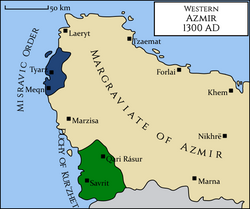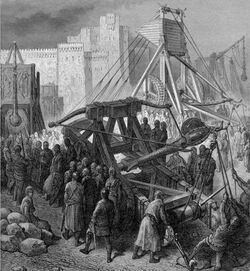Azmiri Crusade
The Azmiri Crusade (1301-1344) was a long-running conflict of the fourteenth century, waged mainly by the Knights of Saint Misrav and Maritime Republic of Cadenza against the Thaerine Margraviate of Azmir. Though prosecuted as a direct consequence of the Fall of Tyarz in September 1301, it is not traditionally regarded as having begun until mid-December, when the Knights' Order Master in Azmir, Saleb Resis, launched a campaign to retake the city. Over the next forty years, with intermittent support from other Crusading orders and the earls of Cadenza, the Knights prosecuted one of the bloodiest wars of the era, in which hundreds of thousands died. Tyarz itself was besieged thirteen times during this period, being recaptured by the Knights on three occasions, but ultimately remained in Azmiri possession.
Historiography
The Azmiri Crusade was not a continuous conflict, being fought intermittently over forty three years by numerous factions at different times. Historians since the early 19th century have grouped the fighting into three broad phases: the initial stage, known as Resis' Crusade, from 1301 to 1305 during which time Saleb Resis was the overseeing commander and the main goal was the reconquest of Tyarz; the Earls' Crusade, from 1305 to 1328, fought by a wide coalition of Astyrian crusading orders coordinated by the Knights of Saint Misrav and assisted by Cadenzan earls and adventurers; and the [ultimate stage], lasting from 1328 until 1344 when the crusaders entered a decline and the bulk of the fighting was assumed by republican troops.
Although termed a crusade, the war was not unambiguously a religious conflict. The Misravic Order were defending territory and had legal obligations to the Christian population in western Azmir. Cadenza itself was formally a religiously pluralist society, and a significant portion of its population were Thaerine adherents. The motivations for the secular state to become involved in the war were initially chiefly political and economic. In its final phase, however, the conflict became much more sectarian in character after Azmir pronounced itself a Ryioist state.
Chronology
Background

- Fall of Tyarz
- Battle of the Field of Olives
Resis' Crusade
Conclusion
The negotiations which concluded the crusade resulted in an extensive set of terms by both sides. An emissary from the Earldom of Jajich was invited to oversee fulfillment of the terms. The Siresian Order was instructed to establish a monastery in Khem as part of a compromise agreement; the site was donated in apology for the despoiling of their monastery at Tyarz.


